#Helium Gas Size
Explore tagged Tumblr posts
Text
Cryocooler Market - Forecast (2022 - 2027)
Cryocooler Market Size is forecast to reach $18.4 billion by 2026, at a CAGR of 8.5% during 2021-2026. Cryocoolers are standalone devices utilized for providing cooling temperatures at different cryogenic levels. There are different types of cryocoolers available based upon the operating thermodynamic cycles. These cycles assist cryocoolers to attain different levels of cryogenic temperatures that are applicable to specific set of applications in plethora of industry verticals. Cryocooler is a mechanical refrigerator designed to cool an application down to cryogenics temperatures. Cryocoolers are significantly used for applications in the transportation/storage of gases at extremely low temperatures as well as cooling of products, particularly infrared products in various applications. Cryocooling solutions have been witnessing a wide popularity across the major end-use verticals including medical, mining, power plants and are subjected to repeated as well as continuous usage, the need for regular maintenance or repair, fixing customer queries in times of malfunctioning, replacing spare parts with new ones and so on becomes highly essential. These services help the end-use customers to continue production activities without causing time delays, operation failures and hampering business productivity.

Report Coverage
The report: “Cryocooler Market Report– Forecast (2021-2026)”, by IndustryARC covers an in-depth analysis of the following segments of the Cryocooler market
By Rotor Type: Inner Rotor, Outer Rotor.
By Type: Single Phase, Three Phase.
By Efficiency Class: IE1, IE2, IE3, IE4.
By Output Power: Upto 350W, 350-700W, 700-1000W, 1-2KW, 2-5KW, 5KW and Above.
By Speed: Upto 500RPM, 500-1000RPM, 1000-2000RPM, 2000-5000RPM, 5000-10000RPM, 10000RPM and Above.
By Voltage: Upto 1KV, 1-6.6 KV, Above 6.6KV.
By Vertical: Industrial, Commercial, Residential, Agriculture, Automotive and Others.
By Geography: North America (U.S, Canada, Mexico), South America(Brazil, Argentina and others), Europe(Germany, UK, France, Italy, Spain, Russia and Others), APAC(China, Japan India, SK, Aus and Others), and RoW (Middle East and Africa).
Request Sample
Key Takeaways
Technical Support services help the users or customers to select best cryocooling components or spare parts according to their industrial requirements, offering details about on-service contracts, or discounted service packages, diagnosis or repairing faults, troubleshooting technical issues along with a proper guidance on servicing intervals. With the help of technical support services, various end-use customers have been able to maximize their productivity with a cost-efficient approach.
Scheduled maintenance had been gaining a wide popularity within the cryocooler market owing to various service providers offering maintenance contracts, emergency support, warranty offers and so on. These services have proved to be a beneficial factor as the cryogenic components including compressors, cold heads and so on helps in early detection of defects or damages, which can ultimately benefit the end-use customers to schedule or pre-book repair or refurbishment services, within lesser costs and efforts.
Applications including cooling in MRI systems, superconducting magnets, low temperature sensors, storage of biological cells or specimens, cyropumps for semiconductor fabrication, cryosurgery and so on are considered as some of the major factors impacting the growth of various cyrogenic hardware over the years.
Cryocooler Market Segment Analysis - By Temperature Range
50K-100K temperature range type hold the highest market share accounting for $649.3 M in 2020 and $906.0 Million by 2026 with a CAGR of 6.3% over 2021-2026. Cryocoolers which can provide cooling within range of 50K-100K are used for applications including liquefaction of nitrogen & mixed gases and cooling the gas temperature ranges from 60-80 K. Cryocoolers that can supply cooling up to the range of 100K are used in Cooling of satellite typically in the milliwatt range at 60-80K. On January 2020, NASA developed a 20 Watt 20 Kelvin cryocooler is a critical step in enabling zero boil-off of liquid hydrogen. Active thermal control of cryogenic propellants is made possible by integrating a cryocooler to intercept and collect heat from the cryogenic tank support structure and/or a broad area cooled shield. 10K-50K temperature range cryocooler type is witnessing fast growth rate with a CAGR of 7.63% during the forecast period 2021 – 2026 owing to the wide range of applications employed in liquefaction of Solid Hydrogen in the temperature range of 10-14K and liquefaction of hydrogen in the temperature range of 18-30 K.
Inquiry Before Buying
Cryocooler Market Segment Analysis - By Vertical
In Power and Energy vertical, applications of cryocooler includes LNG for peak shaving, Infrared sensors for thermal loss measurements, SC magnetic energy storage for peak shaving and power conditioning, SC power applications (motors, transformers etc.). The superconductor industry is closely linked to the cryogenic industry due to operating temperatures required for superconductivity being below 130K. Such cooling comes from cryocoolers. The use of a superconductor and the fact that superconductors currently need a cryogenic temperature to operate means SMES is part of the superconductivity and cryogenics industry. Thus, cryocooler play an important role in creating cryogenic temperatures required for superconductivity. In SMES energy is stored in a magnetic field created by the flow of direct current (DC) in a superconducting coil, which has been cryogenically cooled below its critical temperature. Energy storage is a rapidly growing market with a number of trends. The increase in decentralized renewable energy, the advent of smart grids, smart micro-grids and smart houses, the electrification of transport, the increasing demand on the ageing electricity infrastructure and climate change targets are all helping to drive the energy storage market. Thus, with the increase in energy storage devices such as SMES the market growth for cyrocoolers will increase as it used for direct cooling of superconducting magnets.
Cryocooler Market Segment Analysis - By Geography
Geographically, Asia-Pacific hold major share 33.2% of Cryocooler Market share in 2020 terms of revenue owing to increasing applications in Defense sector, Healthcare and Space sector. For instance, On May 2019, China unveiled the prototype for its sleek new magnetic levitation (maglev) train. Developed by the state-owned China Railway Rolling Stock Corporation (CRRC), the world's largest supplier of rail transit equipment announced that the new train is capable of travelling at a speed of 600km/h. Moreover, India’s Defense Research and Development Organization (DRDO) announced that their Anti-Tank Guided Missile (NAG) is set to be exported to global market and India further look to expand its production units. This will propel the application of cryocooler in large scale further enhancing its market growth. South America region is anticipated to witness the significant market growth during the forecast period 2021-2026 with a CAGR of 7.7%. The market growth in this region is mainly due to rising applications of cryocooler such as to offer high speed imaging and sensing infrared detectors across a variety of different sectors, including space, defense and commercial. With Brazil ramping up domestic space satellite, rocket programs the cryocooler market will grow significantly.
Schedule a Call
Cryocooler Market Drivers
Growing Applications in Military and Defense
The extensive deployment of cryocoolers for defense and military applications such as cooling of infrared focal planes and infrared sensors is likely to be the major driving factor for the growth of global cryocoolers market. Cryocooler are often used for tactical military applications such as airborne, ground mounted and shipboard IR sensors that are associated with cryocoolers for cooling needs. Indium antimonide (InSb), Mercury-cadmium-telluride (HgTeCd) and other prominent detector materials used in these applications are required to be cooled to cryogenic temperatures to ensure proper operation of sensor device by reducing the random transition of electrons between energy bands. Moreover, improving power, size and weight constraints of space qualified cryocoolers boosted the utilization of these devices in large military satellite electro optical infrared missions.
Growing Adoption of Night Vision Cameras
Most of the advanced security cameras are featured with night vision to provide footages of the location even in dark and night conditions. These cameras rely on infrared light and capture footages by lighting the field of view with infrared light source. Night vision cameras installed in military applications such as video surveillance for enemy detection uses cryocoolers. These devices use high efficiency compact pulse tube cryocoolers as cooling element for IR sensing materials to enhance the picture clarity and colour discrimination. The growing demand or night vision cameras in typical commercial applications owing to theft and other anti-social activities is propelling the cryocoolers market.
Buy Now
Cryocooler Market Challenges
Low Efficiency in Closed Cycle Mode and High Internal Losses
The internal losses associated with most of the regenerative and recuperative cryocoolers pose a very significant effect on the overall efficiency of the system and this is the major factor hindering the growth of cryocoolers market. The irreversible gas compression mechanism in cryocoolers results in regenerator inefficiency of the system. Other internal losses such as pressure drop loss and clearance seal loss also impact the performance of the system negatively. The losses experienced by Pulse tube type cryocoolers within pulse tube itself include heat transfer between tube wall and gas, circulation of gas within the pulse tube due to oscillating pressures and mixing of warm and cold gas segments.
Cryocooler Market Landscape
Product launches, acquisitions, Partnerships and R&D activities are key strategies adopted by players in the Cryocooler market. Cryocooler top 10 companies include Sumitomo, Chart Industries, Sunpower, Air Liquide, Janis Research, Ricor, Cryomech and Brooks Automation.
Acquisitions/Product Launches
In September 2020, Air Liquide S.A. acquired Cryoconcept which enabled Air Liquide to strengthen its expertise in the field of extreme, or close to absolute zero, cryogenics.
In July 2019, Atlas Copco acquired Brooks Semiconductor Cryogenics through which it will develop a worldwide sales and service network of cryo pumps operations.
For more Electronics related reports, please click here
#cryocoolers market#spectrometers cryocoolers market price#cryocoolers market report#cryocoolers market research#cryocoolers market size#cryocoolers market shape#cryocoolers market analysis#cryocoolers market forecast#thermodynamic cycles#helium gas
1 note
·
View note
Text
Canonically it has to be hydrogen for the Railroad quest to take them out to work but that makes me unreasonably upset at the writers.
Is the Prydwen filled with Hydrogen or Helium asking for a friend
#I still to this day think about making my own blueprint layout of how the prydwen should look in a more realistic angle than the game shows#(it wouldnt be perfectly sound since my knowledge isnt extensive and so would still rely on heavy fantasy handwaving for some parts#but I can do so much better for her than they did. she deserves it.)#and in my head those gas cells are either filled with straight up helium -some fallout-specific fantasy noble gas similar to helium -#-or fucking double gas cells that use both helium and a safer amount of hydrogen (damage wont make it explode or fall from the sky)#like. im pretty fucking sure the hindenburg happened in the fallout world too#the prydwen is roughly the same size as her so they would have to of taken inspiration and fucking learnt from the mistakes right??#hidengurg was MEANT to use helium in double gas cells! that was part of her original design!#but America (major supplier of helium to the world) wouldnt trade their gas at the time so they changed it to just hydrogen...#like. why would the prydwen be PURPOSEFULLY built with the mistakes hidenburg was aware of and tried to avoid? that lead to it coming down?#fucking. biting the writing team hard#“oh you see its the BoS hubris in action! they dont think someone would know or be able to use that against them!” NO. Its bad writing.#fuzzy.reblog
71 notes
·
View notes
Note
I hope I'm not asking too many questions... but I really love the skywhale trope and wanted to hear your thoughts on them?
i think we need more variety of whales in the sky! seems like more people go for a blue whale or humpback whale design on their sky whales, which is fine because they are very iconic whales and i love the way they look. but how about some beaked or toothed whales? flying orcas? a bowhead? i think a sky whale that looked like a bowhead whale would be just wonderful, look at this thing.
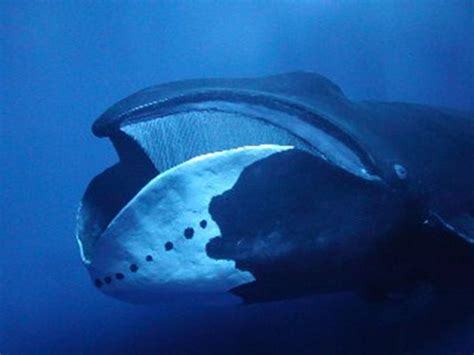

(image description: first is an underwater photo of a bowhead whale's face. the top of its mouth is very narrow while the bottom of it is enormous, like a pelican. there is a white patch at the front of its lower jaw with black spots in a line across it. the second image is a detailed illustration of the whale's whole body, comparing it to the size of an elephant and showing the shape of its fins and tail. the elephant is roughly the size of the whale's lower jaw. end description.)
i love this thing. look at that face. the humpback whale may have longer and prettier fins for that sky whale aesthetic, but the bowhead's face shape is delightful. more diversity in sky whale designs!
but of course, the more interesting thought is how exactly to make such an enormous vertebrate work as a flying animal. where is it going? what does it eat? what happens when it dies?
it would be more realistic for sky whales to be smaller, but when people think of sky whales, they want the huge size! it's a fantasy, we want the epic huge flying creatures with their strange singing calls swimming through the clouds. so i'm not going to talk about the more logical small flying whales that go around in flocks to hunt birds (though the idea of smaller flying dolphins is also delightful!) I'm going to just talk about big slow baleen sky whales, the most iconic and desired of all sky whales.
step one: how the heck are these things in the air. it's easier to explain how a dragon can fly, they have big powerful wings. how do whales fly? I think the clearest answer is that they have some form of massive internal air sac full of lifting gas. real life oceanic whales are full of blubber, but maybe sky whales don't have as much blubber and get a lot of their size from their big air sacs instead.
lifting gas is just an umbrella term for any gases that are lighter than the standard atmospheric air. this includes heated atmospheric air, hydrogen, helium, coal gas, ammonia, and methane. (according to wikipedia) and with that list I think we've found our answer. whales are actually even-toed ungulates like cows. they could easily produce a lot of methane with the right diet. they'd just keep it in their air sacs instead of releasing it as a waste material! and for the best production of methane, these sky whales should have multi-chambered stomachs.
This does mean they're probably going to eat a lot of plant matter! so imagine them swooping low to take huge mouthfuls of tree tops! terrifying! maybe their baleen is structured to scrape the leaves off the branches. Maybe they swoop down to kelp forests in the ocean and take huge mouthfuls of that as well. any critters they happen to consume in the process are just bonus snacks full of protein. they likely also consume large flocks of small birds on the go, and probably clouds of flying insects too! locust swarms, for example. watch out for the low flying whales! I think they'd be slow like blimps and mostly use their tails and fins to steer and swoop down for food. they probably also rub themselves on tree branches or mountain sides to scratch their itches. I bet they'd have a symbiosis with many bird species that pick off their parasites.
like cow manure, sky whale dung could be a great source of fertilizer. best to avoid the usual paths of migrating sky whales so you don't end up dead by having giant poop clumps fall on you, but once it's hit the ground, that's free whale manure for every farmer in the area. the lands along the paths of migrating sky whales are probably very fertile, which also serves the whales, since they'll be eating the leafy tree tops! and when a whale dies, falling to the ground, the resulting small earthquake would certainly be startling, and both the impact and the rot process would cause a lot of damage to the surrounding land.
things are not immediately fertilized when a corpse rots. it takes a while! the rot causes more harm at first and then starts to nourish the ground later.
and dead bodies tend to bloat with gases and i have already established that these whales are full of methane. a lot of it would be released at death anyway, and i don't think the whale would drop immediately. or perhaps they fly lower in their old age and just crash land and die slowly. either way, these things are huge and full of methane and then they bloat. which means they might also explode spontaneously as part of the decay process. the air for miles around is going to be so nasty. but i think if you live in sky whale territory, you're just going to have to get used to the stink, because the manure that falls on a more regular basis is also going to be so so stinky.
like real world whale falls, sky whale falls will attract absolutely every carnivorous creature in the area. anything that eats meat will follow that awful stench right to the source and start gnawing away at the thick skin. people will have the easiest time, since they have tools for this beyond just their teeth and claws. the faster the whale is cut open, the less likely there will be an explosive bloat stage, so I'm sure the culture of the region would have some superstitions about leaving a dead whale lying too long. if you don't go harvest that bounty, it will explode and you never know where those chunks will land.
and then when there's only bones, people use em for building all sorts of things! the societies that exist in the paths of sky whales would be very cool to see.
that turned into a ramble and I haven't even designed a sky whale lol. lemme doodle one real quick.

(image description: a sketch of a sky whale, which resembles the aforementioned bow whale, swooping down to munch on trees in a forest. end description.)
92 notes
·
View notes
Text
As you might know, the sky is due to get a new star any time now, in a few months at most.
What is happening? The recurrent nova T Coronae Borealis, by far the brightest one known, is a star* in the northern constellation Corona Borealis that, once every 80 years or so, increases in brightness from completely invisible by naked eye to among the ~100 brightest in the night sky. This increase is called a nova, from the Latin word for new, as it looks like a new star has appeared.
Where can i see it from? Basically all human inhabited latitudes, all except the far south. In the northern latitudes, however it is visible the entire night, while near and below the equator you will need to 'catch' it at the right time of night, which in August and September is just after sunset.
How will it look? Let's not get your hopes up too high. It will, at the brightest, reach a magnitude around 2 at most, so about as bright as the north star, relatively unremarkable and completely unnoticeable as unique to someone who doesn't know where to look. But still, it's the most visible sudden change to the relatively fixed pattern of the heavens any of us will live to see, so you should still go give it a look.
Where is it? Currently, the constellation is best visible about 1 or 2 hours after sunset. You will need to be relatively far away from light pollution, so at least a couple dozen stars are clearly visible. While learning the constellations, and finding the star by orienting via those is imho half the fun, you could use one of many sky map apps and websites to tell you the star's location. If it didn't happen yet, there should be nothing visible at that location. However, if there is, congrats! You just did an astronomy™ :3

It will appear in the circle next to the star labeled ε
Why is this happening? Most stars spend most of their lives in a stable, hydrogen fusing state. However, when hydrogen in their cores begins to run out, they switch to helium fusion, which makes them swell up to enormous sizes, turn red due to lower surface temperature, and are thus called red giants. After this helium runs out, the star will (in most cases) throw off the inflated outer layers, while its hot, dense core shrinks and keeps on glowing due to how hot it is, while not actually doing any fusion and not producing any new energy. Those are called white dwarfs, and because they don't fuse, aren't technically stars at all, therefore the asterisk in the first sentence of this post. The T-CrBo system is a red giant and white dwarf binary, where the red giant has grown so big, that the parts of it closest to its partner aren't gravitationally bound to it anymore. Therefore, the gas falls and accumulates on the white dwarf's surface (which otherwise has no hydrogen on its own), untill a critical point is reached where the pressure of the gas causes it to all fuse at once, resulting in a huge thermonuclear explosion bright enough to be seen from over 2500 light years. The explosion however, isn't big enough to blow the dwarf apart, and it starts accumulating new matter from its partner right away. Because of this, it with re-explodes every 8 decades, and it is due to go any day now.

@green-mountain-goose @brightgreendandelions
#astronomy#recurrent nova#science#astrophysics#space#not a reblog#t coronae borealis#long post#ramblings#space observation
107 notes
·
View notes
Text
Please consider reblogging this so it gets seen outside my followers!
53 notes
·
View notes
Note
Hello again! I've returned with another fic roulette request!
I would love to see what you can do with 2 and 31 Tech and f!reader. Please and thank you~ (Apologies for another Tech request, I'm a wee bit of a Tech girlie. ^^' )
Hello gorgeous,
I'm a Tech girlie too, so don't worry. I love our lovable nerd clone. He's so adorable.
I hope you enjoy this fic, since you didn't specify a platonic relationship, I didn't write one. I hope that's okay.
Also all the star talk is copied from Study.com, 'What Causes a Star to Shine Brightly?' article. Thank you to the writer for providing a great synopsis I could use.
Also it got a bit long at 1400+ words.
Love oo,
Just a Dream
Warning: Fluff, anxiety, force sensitive reader, possible character death, fear, nightmare, information dumping, I think that's it, if I miss any please let me know.

Main Master List | Star Wars Fic Roulette
The house was quiet, the island was quiet, not surprising when it was nearly two in the morning. You did your best to try and sleep, but you couldn’t. You kept having the same dream, a secret meeting with Imperial commanders. An explosion that dislodges a cable car. Tech hanging from a rappelling cable. No matter how hard you tried to push those images away, you couldn’t. Something about Tech dangling over nothing from a rappelling cable put knots in your stomach. You grabbed the shawl one of the villagers made you, they said you looked like the kind that indulged in warmth. She was a kind older woman, and you couldn’t say no.
You tightened the shawl around as you sat on the patio chairs that had been donated to you and the Bad Batch. It was their way of welcoming all of you and honestly, you were beyond overwhelmed by Pabu’s hospitality and openness. You never wanted to leave here.
As quietly as possible you moved the chair away from the patio table, took a seat and looked up watching the stars, trying to calm down your mind.
It was a few minutes before you heard the door to the house close and footsteps coming to join your side.
Tech sat down and looked up to the stars with you, he knew if you were out here it usually had to do with a nightmare that wouldn’t leave your mind or it had to do with some anxiety you were going through at the moment.
“Do you know a star is a glowing body of gas and plasma? The reason a star glows is that it uses nuclear fusion to fuse hydrogen atoms into helium nuclei producing both heat and light. Scientists can determine what elements make up a star by looking at the emission spectra of the light they produce.”
You turned your head looking at him smiling, enjoying listening to his voice.
“There’s a star that is known as a red dwarf star, it’s smaller and cooler than main-sequence stars. However, due to their dimensions and cooler temperature they are too dim to be seen by the naked eye. You need a telescope in order to see them. And some have been estimated to have a life span of 10 trillion years.”
As you listened to his soothing voice you couldn’t help but smile and keep looking at him as you turned fully to face him, keeping the shawl close, shutting out the cold air.
“What other star is there?”
“Well I’ve also read about red supergiant stars. Now these stars have fused all their hydrogen, so now they are fusing helium into carbon. Causing the star to expand in size until all the helium runs out in about one to two million years. The stars with the coolest temperatures appear red, and when a red supergiant star dies, it explodes into a supernova.”
You smirked as you listened to him, “When did you learn all this stuff about stars?” You asked him as you watched him turn his head to look at you.
“When I learned you enjoyed looking at the stars.”
“You didn’t have to do that.”
“Yes, I did. You are important to me, and what you find enjoyable is important to me too.”
“You’re always there for me, aren’t you?”
"I will always be there for you. Whether you need me to simply info dump so your brain turns off, or you need someone to sit beside you in silence and hold your hand. I’ll always be there for you.”
As he said those words the image of him dangling from the rappelling cable came back into your mind, your smile fading as the sense of dread from before filled you again.
He didn’t have to ask to see what something was wrong, he moved his chair closer, and gently caressed your head, holding your hand, “Hey, hey, shhhh. Shhhh. You’re okay. Hey, look at me.” He tilted your head, using his forefinger to lift your chin, until your eyes met his.
“What’s wrong?” He gently wiped the tears that had been silently falling down your cheeks, “What is it? Was it a nightmare?”
You simply nodded afraid that speaking what you feared may come true.
“Was it a bad dream?”
Well that’s the thing, it wasn’t necessarily a bad dream, but the feeling that came with the dream is what made it worse. It was almost as though your heart was preparing you for a loss that you hadn’t even experienced yet, “I … I don’t know.” You finally answered, giving the only answer you really could.
Tech tilted his head as he looked at you, slowly guiding you out of your chair, to sit on his lap as his arms wrapped around you, gently rubbing your back as you tucked your head into his neck, wanting to hide from everything.
“Well… can you tell me what’s got you so upset. Was it something in the dream? Or was it something you realized because of the dream?”
“It …. It didn’t really …” you took a breath and closed your eyes as you wrapped your free arm around Tech holding him close, “It was about you.”
“Me. Okay. What about me? Did I say something wrong?”
“No.”
“Was I mean to you?”
“No.”
“Did this have to do with a mission?” You were silent. “Okay, a mission. Did something go wrong in the mission?”
“I don’t know… I think so. I saw an explosion.”
“Okay. Explosion, was someone injured because of the explosion?”
“No.”
“Was I in danger because of the explosion?”
“I don’t know.”
“Okay, well what can you tell me?”
“You were dangling.”
“Dangling. Was I holding on to something for dear life, dangling? Or was I gripping onto Wrecker’s arm, and waiting for him to pull me back to safety dangling?”
“You were hanging over nothing from a rappelling cable. I know it doesn’t sound bad, but … I have this feeling.”
“Feeling?”
“Yes. I feel as though … I … I’ll lose you.”
Tech didn’t speak for a second, processing what you were saying, trying to understand the fear that had somehow embedded itself into your heart.
“So … you think I’ll die on this mission that we haven’t planned or even expected.”
“I don’t know how to explain it, but … I feel something big is going to happen, and because of that … we’ll be forced to make a decision. And because of that decision … I’ll …” your voice died down, barely above a whisper as you were about to answer him, “I’ll lose you. Forever.”
He let out a sigh, as he turned his head to kiss your forehead and wrapped his arms tighter around you, “Death is part of life, cyar’ika. You know that, I know that. These dreams … I know your force sensitive, not a Jedi, but at least somewhat knowledgeable of the force, and … it could mean a lot of things. It could mean that I’m simply dangling out in the open for a short amount of time. Could mean that I need to pack a second rappelling gun, in case the first one gets jammed it doesn’t mean I’m going to die.”
He took a minute to breathe in your scent leaving another kiss on your forehead, “And even if I die, it won’t change how I feel about you. How I’ve always felt about you. Ner cyare, please know that the time I’ve spent with you, being loved by you, having the privilege to love you in return has been some of the happiest and most loveliest days of my life. I look forward to every morning and night, because you’re there to make it better. I’m not saddened by the fact I may have to face my death, because I have no regrets.”
“I don’t want you to go” you stated, trying to fight back the tears despite the pricks you felt, “I’d rather have you alive and beside me. I …” you voice trembled as your bottom lip quivered, “I’m not ready to let you go.”
“Cyare, it was just a dream. I’m not going anywhere. Like I said there are no missions we plan on taking or are planning. I’m going to be right here.”
Tech held you for the rest of the night, even when you went back to your quarters, he didn’t stop holding you, keeping you pressed against him hoping to calm your fears and worries. He didn’t want to tell you, but the fact you may have dreamt his death, unnerved him a little. He shook the idea out of his mind, there was no need to worry. There were no missions coming up.
At least that’s what he thought, until he received the distress call from Crosshair.
Main Master List | Star Wars Fic Roulette
Tag list:
@liadamerondjarin @badbatch-simp24@spicymcnuggies@lady-ren @firstofficerwiggles @darkangel4121 @discofern @kavecika @monako-jinn-stories @ladykatakuri @avathebestx @theroguesully @furyhellfire66 @carodealmeida @ciramaris @sprout-fics @twinkofthedink @dindjarin-mandalorian @ulchabhangorm @littlemisspascal @tortor-mcgee @vodika-vibes @clonethirstingisreal
#star wars#450 follower celebration#Star Wars fic roulette#SW Fic Roulette#450 FOLLOWER CELEBRATION#Follower Celebration#Star Wars Fic Roulette#Fic Roulette#star wars the clone wars#star wars: the clone wars#starwars#pick your character#pick your prompt#the clone wars#the Mandalorian#Andor#Book of Boba Fett#original trilogy#Obi-wan#Ahsoka#The Bad Batch#star wars prequels#star wars sequel trilogy#the bad batch tech#tech x reader#tech#tbb tech#bad batch tech
129 notes
·
View notes
Text
The Year’s Most Spectacular Photos from the James Webb Telescope
By Jeffrey Kluger
December 22, 2023

Close to 1,500 light years from Earth lie a pair of baby stellar twins known as Herbig-Haro 46/47 — which are barely a few thousand years old.
A star the size of our sun, by contrast, takes an average of 50 million years to reach even the stellar equivalent of young adulthood It's Herbig-Haro 46/47's extreme youth that gives the formation more of a blob-like appearance than the stellar duo it is.
Young stars are buried in clouds of dust and gas, which they absorb as they grow. Sometimes, however the infant stars ingest too much material too fast.
When that happens, dust and gas erupts from both sides of the formation, giving the young pair their misshapen look.
But if you have patience — 50 million years worth of patience — what is a blob today will be stars tomorrow.
NASA, ESA, CSA. Image Processing: Joseph DePasquale (STScI)
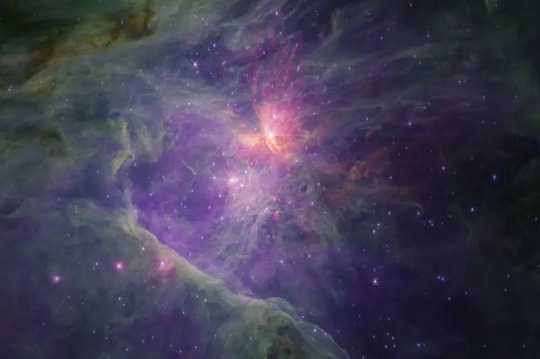
A pair of brilliant stellar nurseries located 1,600 light years from Earth, the Orion Nebula and Trapezium Cluster are home to a relative handful of very young but very bright stars.
Four of the stars are easy to see with a simple, amateur, four-inch telescope.
One of the four — the beast of the young litter — is especially visible, a full 20,000 times brighter than our sun.
Apart from their four main stars, the Orion Nebula and Trapezium cluster contain approximately 700 additional young stars at various stages of gestation.
NASA, ESA, CSA/Science leads and image processing: M. McCaughrean, S. Pearson, CC BY-SA 3.0 IGO

(L): It’s not easy being a Wolf-Rayet star, like this specimen imaged by the Webb telescope at a distance of 15,000 light years.
A rare species of stellar beast — NASA estimates there are only 220 of them in a Milky Way galaxy with at least 100 billion stars — the Wolf-Rayet burns hot and burns fast, with temperatures 20 to 40 times the surface of the sun.
All of that rapidly expended energy causes the star to lose its hydrogen envelope quickly and expose its helium core.
The result: a very early and very violent death.
A star like our sun burns for about 10 billion years. As for a Wolf-Rayet? Just a few hundred thousand before it dissolves into cosmic dust.
NASA, ESA, CSA, STScI, Webb ERO Production Team
(R): If the Wolf-Rayet star dies an ugly and violent death, the celebrated Ring Nebula, photographed by the Webb at a distance of 2,000 light years from Earth, has been expiring beautifully.
The glowing remains of a sun-like star, the nebula was discovered in 1779 by the French astronomer Antoine Darquier de Pellepoix.
As the nebula throws off its outer layers of ionized gas, it reveals its characteristic blue interior, composed of hydrogen and oxygen that have not yet been expelled off by the nebula’s stellar wind.
ESA/Webb, NASA, CSA, M. Barlow (University College London), N. Cox (ACRI-ST), R. Wesson (Cardiff University)
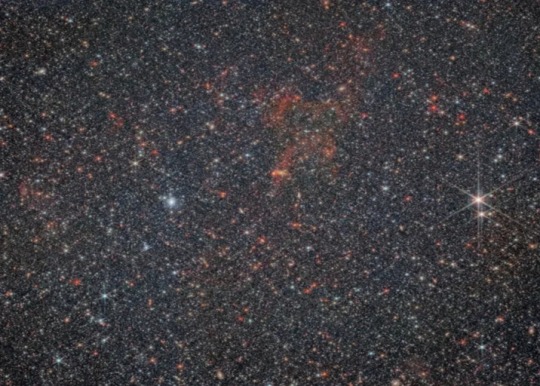
Dwarf galaxy NGC 6822 lives up to to its name — home to just 10 million stars, compared to the minimum of 100 billion in the Milky Way.
But what NGC 6822 lacks in numbers, it makes up in spectacle — which the keen eye of the Webb telescope has revealed.
Discovered in 1884 by American astronomer E.E Barnard, NGC 6822, is now known to have a prodigious dust tail measuring 200 light years across..
What's more, it's home to a dense flock of stars that glow 100,000 times brighter than our sun.
ESA/Webb, NASA & CSA, M. Meixnev

Spiral galaxies are often defined by uneven — and even ragged — arms.
But not galaxy M51, which lies 27 million light years from Earth and is defined by the tautness of its arms and the compactness of its structure.
M51 isn't alone in space. Nearby lies the companion galaxy NGC 5195.
The two galaxies are engaged in something of a gravitational tug of war — one that the NGC 5195 is winning.
NGC's constant gravitational pull is thought to account for both the tightly woven structure of M51's arms and for tidal forces that are thought lead to the creation of new stars in the arms.
ESA/Webb, NASA & CSA, A. Adamo (Stockholm University) and the FEAST JWST team
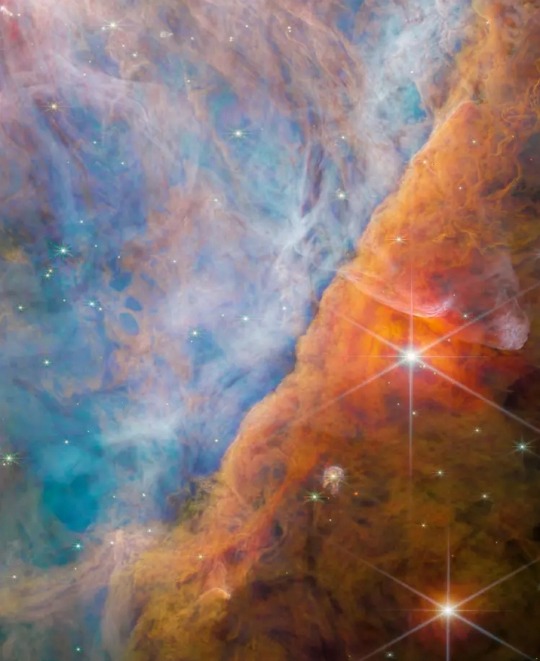
Just below Orion’s belt lies one of the most celebrated objects in the night sky: the Orion Nebula, a stellar nursery that is home to about 700 young stars.
This Webb image focuses not on the entirety of the nebula but on a structure in the lower left-hand quadrant known as the Orion Bar.
So named because of its diagonal, ridge-like appearance, the bar is shaped by the powerful radiation of the hot, young stars surrounding it.
ESA/Webb, NASA, CSA, M. Zamani (ESA/Webb), and the PDRs4All ERS Team

A baby by stellar standards, the IC 348 Star cluster is just five million years old and located about 1,000 light years from Earth.
Composed of an estimated 700 stars, IC 348 has a structure similar to wispy curtains, created by dust that reflects the light of the stars.
The conspicuous loop in the right hand side of the image is likely created by the gusting of solar winds blowing in the direction that, from Earth, would be west to east.
NASA, ESA, CSA, STScI, Kevin Luhman (PSU), Catarina Alves de Oliveira (ESA)
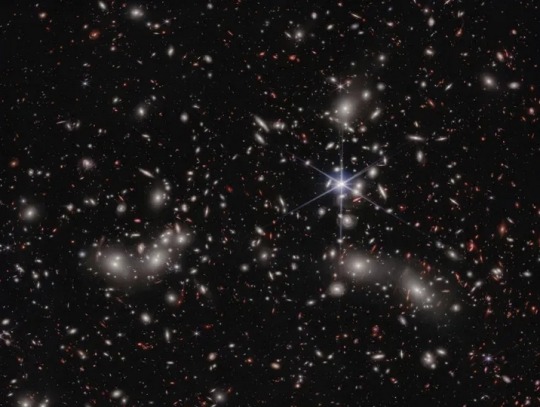
When it comes to galaxies, there's big and then there's huge and by any measure, Pandora's Cluster — more formally, known as Abell 2744 — qualifies as the latter.
Not just a galaxy, and not even a cluster of galaxies, Abell 2744 is a cluster of four clusters, which long ago collided with one another.
Located 3.5 billion light years from Earth, Pandora's Cluster measures a staggering 350 million years across.
The cluster's massive collective gravity allows astronomers to use it as a gravitational lens, bending and magnifying the light of foreground objects, making them easier to study.
NASA, ESA, CSA, I. Labbe (Swinburne University of Technology) and R. Bezanson (University of Pittsburgh). Image processing: Alyssa Pagan (STScI)

Webb was built principally to look at the oldest and most distant objects in the universe, some of 13.4 billion light years away.
But doesn't prevent the telescope from peering into its own back yard.
This image of Saturn and some of its 146 moons, rivals the images obtained by the Pioneer and Voyager probes.
NASA, ESA, CSA, STScI, Matt Tiscareno (SETI Institute), Matt Hedman (University of Idaho), Maryame El Moutamid (Cornell University), Mark Showalter (SETI Institute), Leigh Fletcher (University of Leicester), Heidi Hammel (AURA). Image processing: J. DePasquale (STScI)
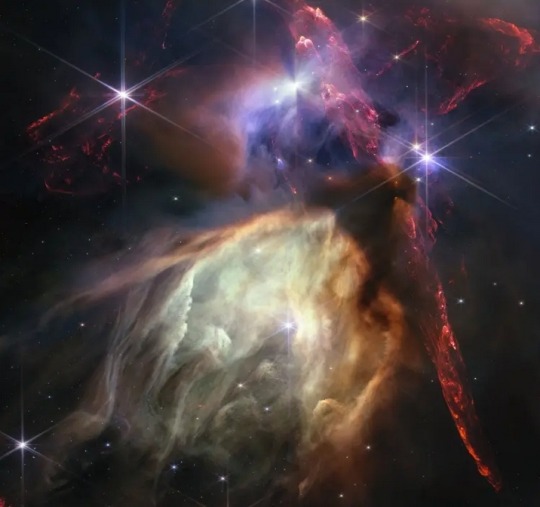
Infant stars are born all over the universe, but the closest stellar birthing suite to Earth is the Rho Ophiuchi cloud complex, located just 460 light years distant.
A turbulent — even violent — place, Rho Ophiuchi is defined by jets of gas roaring from young stars.
Most of the stars in this comparatively modest nursery are more or less the size of the sun.
But one, known as S1, is far bigger — so much so that it is self-immolating, carving a great cavity around itself with its stellar wind, the storm of charged particle's all stars emit, though few with the gale-force power of S1.
NASA, ESA, CSA, STScI, Klaus Pontoppidan (STScI)
#James Webb Telescope#James Webb Space Telescope#telescope#space#stars#galaxies#universe#cosmos#astronomy#space photography#photpgraphy#NASA#galactic clusters#milky way galaxy#Orion’s belt#Orion Nebula#Orion Bar#Pandora's Cluster#Saturn#Rho Ophiuchi cloud complex#Trapezium Cluster#Wolf-Rayet#Ring Nebula#Antoine Darquier de Pellepoix#E.E Barnard#spiral galaxy#nebula
112 notes
·
View notes
Text
Unveiling Saturn- a few lesser known facts

source
Saturn, the majestic ringed planet, often steals the spotlight in our cosmic lineup. But did you know there's more to this gas giant than meets the eye?
1. Saturn's Many Moons: While almost everyone knows Saturn has a bustling entourage of over 80 moons, it’s lesser known why.
Saturn's numerous moons are a result of its massive size and gravitational influence. As the second-largest planet in our solar system, Saturn exerts a powerful gravitational pull, allowing it to capture and retain many objects in orbit around it. Additionally, its proximity to the asteroid belt provides a steady supply of potential moon candidates.
Many of Saturn's moons are believed to have formed alongside the planet during the early stages of the solar system's formation, as material in the protoplanetary disk coalesced to form both the planet and its moons. Others may have been captured later as Saturn migrated in its orbit or as it encountered passing objects.
The complex interplay of gravitational forces among Saturn's moons, as well as tidal effects from Saturn itself, contribute to the diversity and number of moons. Some moons may be locked in resonance with each other, stabilizing their orbits, while others may experience tidal heating and geological activity, shaping their surfaces and interiors.
In summary, Saturn's extensive moon system is a result of its size, gravitational pull, orbital dynamics, and its location in the solar system, making it one of the most moon-rich planets known.
2. The Hexagonal Storm: Deep within Saturn's atmosphere lies a peculiar hexagonal-shaped storm at its north pole (as seen in the image below). This bizarre weather phenomenon, discovered by the Voyager mission in the 1980s, continues to puzzle scientists to this day. How and why it formed remains one of Saturn's enduring mysteries.
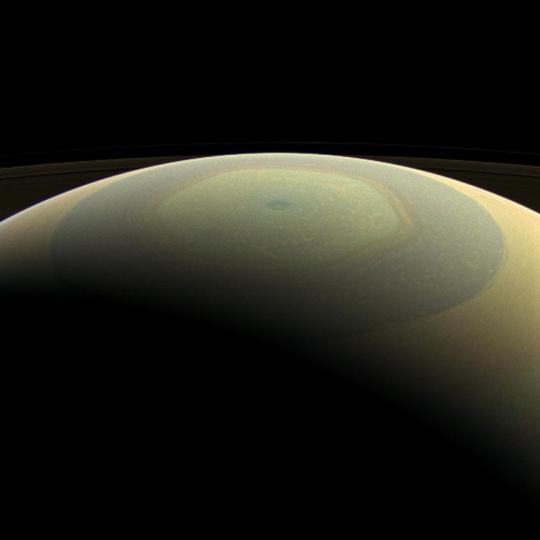
3. Saturn's Density Dilemma: Despite being known as a gas giant, Saturn is surprisingly less dense than water! If you could find a bathtub large enough, Saturn would actually float in it. Its low density is due to its composition of mostly hydrogen and helium, making it one of the lightest planets in our solar system.
Who Discovered Saturn?
Saturn's discovery is shrouded in ancient history. While it's difficult to pinpoint a single individual credited with its discovery, the planet has been observed by civilizations throughout history.
Galileo Galilei: In 1610, Galileo became the first person to observe Saturn through a telescope. However, due to limitations in his telescope's optics, he mistook Saturn's rings for large moons on either side of the planet.
Christiaan Huygens: It wasn't until 1655 when Dutch astronomer Christiaan Huygens correctly identified Saturn's rings as a disk surrounding the planet. His discovery revolutionized our understanding of Saturn's unique features.
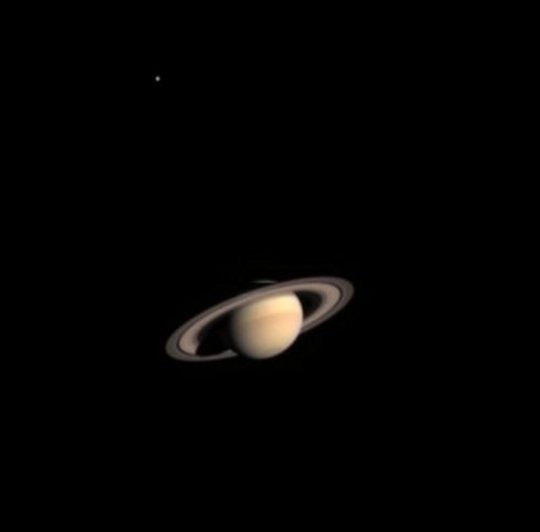
first ever colored picture taken of Saturn source 1
source 2
#astronomy#astro observations#astro community#saturn#saturn posts#outer space#planets#space#galaxy#milky way#its saturn saturday my guys :D
46 notes
·
View notes
Text
HOW WAS OUR SOLAR SYSTEM CREATED?? PT.2
Blog#397
Wednesday, May 1st, 2024.
Welcome back,
Close to the young sun, the heat and light were too intense for anything other than rocky material to remain; the ices evaporated and the loose gas like hydrogen and helium simply blew away. Those remaining rocky bits slowly coalesced, sticking together to form ever-larger clumps.
Eventually, with enough time (and the universe always, always has plenty of time to spare), those bits formed planetesimals, small almost-planets. There were a lot of them, and it was quite a violent time for our solar system as these planetesimals collided, shattered and reformed countless times.
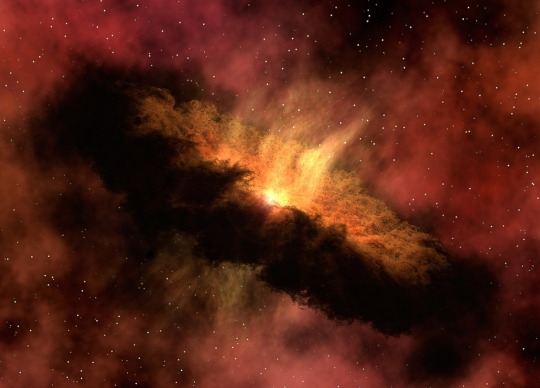
Our own Earth was struck by something nearly the size of Mars, and the debris from that impact eventually became our moon.
Out past what would eventually become the asteroid belt, however, planet formation took a different approach. Out there, it was cold enough for ices to survive, allowing planetary cores to grow to immense proportions in a short amount of time. Those large cores were then able to hoover up any surrounding material, like hydrogen and helium gas, enveloping those worlds in thick, swaddling atmospheres. That's how the giant planets were born.
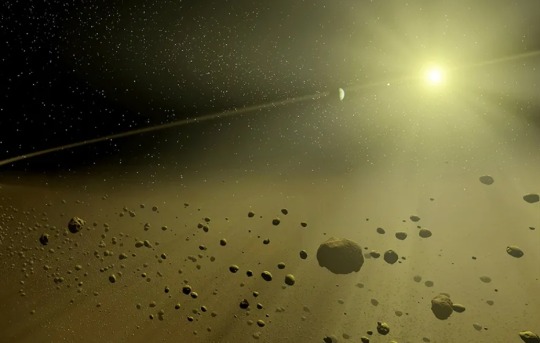
Once the planets matured, however, all was not calm in the solar system. The inner rocky worlds had stabilized, and the sun had ignited nuclear fusion. But the outer giant planets were surrounded by swarms of hangers-on — the leftover bits of debris from the chaotic planet-building process.
So they began to dance.
Astronomers suspect that the four giant planets of our solar system — Jupiter, Saturn, Uranus and Neptune — initially formed much closer together than they are today, and subtle interactions with the remaining debris surrounding them caused them to shift their orbits.
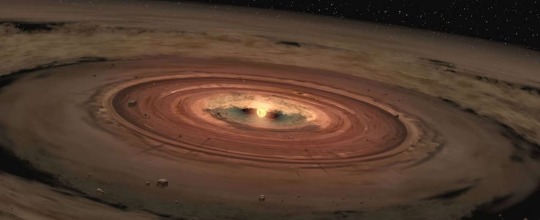
It took hundreds of millions of years to resculpt our solar system, and we're not exactly sure how it all went down.
In one scenario, Jupiter and Saturn migrate inward toward the sun, which caused Uranus and Neptune to drift outward. In another scenario, the worlds of our outer solar system play a game of gravitational hot potato with a bonus fifth giant planet that eventually got ejected altogether. In yet another, Jupiter wanders nearly to the orbit of Mars before jumping back out, disrupting the otherwise placid orbits of the remaining outer worlds.
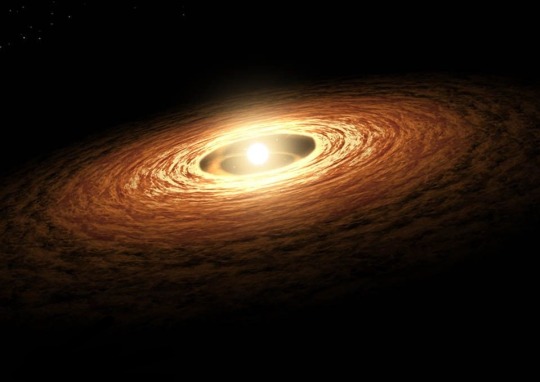
No matter what, this last reshuffling caused havoc. Astronomers think that the migrating outer planets gave rise to an epoch called the Late Heavy Bombardment, a period of intense comet and asteroid impacts in the inner solar system about 4 billion years ago. The shifting of the giant worlds disturbed all the remaining material in the solar system, either sending them to safety in the frozen outskirts or barreling inward to cause trouble for the rocky planets.
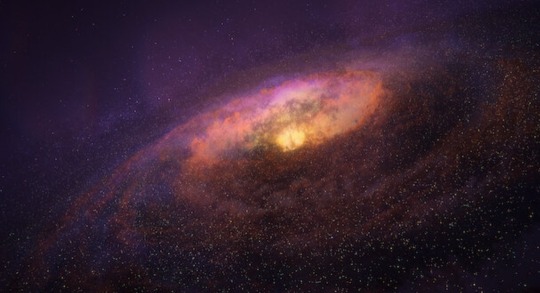
Despite the violence, it wasn't all bad: the procession of comets raining in toward the inner solar system delivered an abundance of water to the rocky worlds, potentially making life, including us, ultimately possible — once the solar system settled down, of course.
Originally published on https://www.space.com
COMING UP!!
(Saturday, May 4th, 2024)
"DOES THE MOON HAVE OXYGEN??"
#astronomy#outer space#alternate universe#astrophysics#universe#spacecraft#white universe#space#parallel universe#astrophotography
50 notes
·
View notes
Text
" Jupiter " //© Hypertech
" Ever wondered why Jupiter is so much larger than the other planets in our solar system? 🌟 It’s because Jupiter is not your typical planet – it’s a fascinating failed star! 🔭🌌 Like our Sun, Jupiter is mainly made up of hydrogen and helium. 🌞 During the formation of our solar system, Jupiter gathered dust and gas, slowly growing in size. However, it never quite reached the mass needed to kickstart nuclear fusion and shine as a star. ⭐️ If Jupiter were about 80 times more massive, it would have ignited fusion and become a star itself! Instead, Jupiter became an impressive gas giant, proudly claiming the title of the largest planet in our solar system. "
© Original Audio
#Space#Planets#Sun#Earth#Moon#Mercury#Venus#Mars#Jupiter#Saturn#Neptune#Uranus#Pluto#Solar System#Galaxy#Galaxies#Milkyway#Universe#Mass#Nuclear Fusion#reels#aesthetics#wanderlust#explore#follow#discover
85 notes
·
View notes
Note
please please please PLEASE share more on your Thoughts about gas giants!! i'd love to learn in a way that doesnt leave me baffled and half my brain leaking from my ears! you explained things so well in the psyche post and also i think things are generally more fun to learn from someone who is Excited To Share than from Published Research Papers where everything has been dried out For Professional Reasons- understandably so, mind, but i am not In The Field and dont know the terms lol
Okay it's taken me forever to get back to this but I AM SO GLAD YOU ASKED.
Like other planets, it all starts with a disk made of gas and dust orbiting an infant star, called a protoplanetary disk. Like these in the Orion Nebula, discovered by the Hubble!

To form terrestrial planets (rocky planets with relatively thin atmospheres like Mercury, Venus, Earth, and Mars), the gas in the protoplanetary disk coalesces to form hundreds and hundreds of rocky bodies called planetesimals, about a kilometer across. These planetesimals collide, and form dozens of protoplanets about the size of the moon. The protoplanets then collide as well, and stabilize to form the solar system as we know it today.
But, in the case of gas giants, colliding protoplanets don't form fully-finished planets. Instead, they form a core, or a seed.
We think the only thing that determines whether a planet will be terrestrial or a gas giant is simply how far away from the sun it forms - that's it. As a new sun warms its evolving solar system, it heats up the material in the protoplanetary disk. Close to the sun, the disk gets hotter, and things like water and other ices melt and evaporate into gas, making them difficult for the protoplanets to gravitationally capture. However, further away, the icy compounds stay cold enough to remain solid and coalesce along with rocky particles.
That boundary in the solar system - where ices evaporate to gas on the sunward side, and remain solid on the other - is called the "Frost Line". In our solar system, the Frost Line is right between Mars and Jupiter.
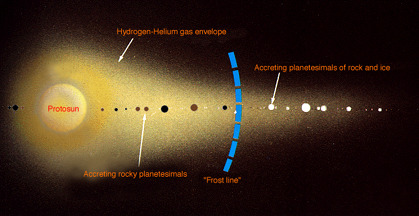
The protoplanets that form past the Frost Line turn into gas giant seeds, and are able to (kinda literally) snowball, picking up both rocky and icy material. With all that solid ice available, they grow far larger and far faster than planets in the inner solar system, and their gravity gets stronger and stronger. More gravity causes them to collect even MORE material until they're heavy enough to capture extremely lightweight elements like hydrogen and helium. Which, of course, makes them get even bigger and even heavier! Runaway growth!
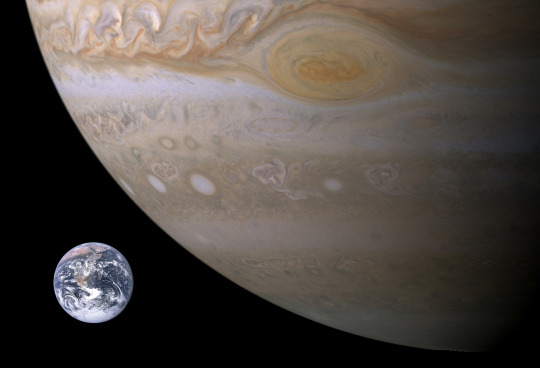
But weirdly, as we study more exoplanets (planets that orbit stars other than our sun), we keep finding these huge gas giants incredibly close to their stars! Like, even closer than Mercury is to ours, which is insane. These "Hot Jupiters" break so many rules - gas giants "should" only be able to form where ice stays frozen, but here they are up close and personal with their stars, like this artist's concept!

It's possible that these planets are in the process of migrating closer to their stars, and we're managing to see them before they evaporate, but we just! Keep! Finding them!
One of my favorite parts of planetary science is how much we still have to learn. We'll think we have a pretty good idea of how things work out there, and then suddenly we'll find something that we can't explain. And there's an entire universe of weird shit - we've barely begun to scratch the surface!
#space#planets#jupiter#gas giants#astrophysics#planetary formation#Hubble#spost#asked and answered#anxiousdemifaemess#it's crazy though#in the early solar system about 98% of the material in the protoplanetary disk is hydrogen and helium#which is so lightweight it's entirely unavailable for planetary formation#it never coalesces and eventually just blows away#or gets eaten by the star#gas giants are able to utilize even a tiny fraction of that material#which is why they get so big!#The Frost Line is the reaso all our gas giants are far away and why we don't see rocky planets like mars hanging out past Jupiter and Satur#Or rather it would be#IF HOT JUPITERS WEREN'T EVERYWHERE RUINING THAT THEORY
145 notes
·
View notes
Text
What is an Exoplanet?
So far scientists have categorized exoplanets into the following types: Gas giant, Neptunian, super-Earth and terrestrial.
The planets beyond our solar system are called “exoplanets,” and they come in a wide variety of sizes, from gas giants larger than Jupiter to small, rocky planets about as big around as Earth or Mars. They can be hot enough to boil metal or locked in deep freeze. They can orbit their stars so tightly that a “year” lasts only a few days; they can orbit two suns at once. Some exoplanets are sunless rogues, wandering through the galaxy in permanent darkness.
Types of exoplanets

Each planet type varies in interior and exterior appearance depending on composition.
Gas giants are planets the size of Saturn or Jupiter, the largest planet in our solar system, or much, much larger.
More variety is hidden within these broad categories. Hot Jupiters, for instance, were among the first planet types found – gas giants orbiting so closely to their stars that their temperatures soar into the thousands of degrees (Fahrenheit or Celsius).
Neptunian planets are similar in size to Neptune or Uranus in our solar system. They likely have a mixture of interior compositions, but all will have hydrogen and helium-dominated outer atmospheres and rocky cores. We’re also discovering mini-Neptunes, planets smaller than Neptune and bigger than Earth. No planets of this size or type exist in our solar system.
Super-Earths are typically terrestrial planets that may or may not have atmospheres. They are more massive than Earth, but lighter than Neptune.
Terrestrial planets are Earth sized and smaller, composed of rock, silicate, water or carbon. Further investigation will determine whether some of them possess atmospheres, oceans or other signs of habitability.
References:
#astrophysics#cosmos#cosmology#planetary science#nasa#space#astronomy#exo planet#top#viral#planets#galaxy#solar system#celestial#celestial body
14 notes
·
View notes
Text
In a future where humans mingle with aliens, we can no longer share culture through food, so I think we’ll instead carry jars of dirt, and explain our corner of the universe from the ground up.
“This is the soil from my hometown; see how red it is? That’s from the aluminum oxides. Actually, I think it was originally settled to mine bauxite. Aluminum isn’t good for Earth plants, so we didn’t have great biodiversity, but the soil did support lots of small edible fruits for my grandmother’s garden. Here, read the list of compounds. If none are toxic to you, you’re allowed to touch it.”
“You think your soil is bad for plants? My soil is worse. High calcium content, no organic components, large particle size. . . water just goes right through it! Look, the grains in this stuff are so smooth that anything built on top of it would sink. This means all our buildings are on sand from another continent, but it also makes it nice and soft.”
“Ha, I grew up orbiting Venus! My family lived opposite the sun, in perpetual twilight, just for the magnetosphere and a stream of this sweet, sweet ‘soil.’ It’s notable for the light gasses - hydrogen, helium, oxygen, and water vapor. I’d like to move back someday, but as Venus loses more and more gas, the average unit needs more and more air processors, so real estate has gotten expensive.”
79 notes
·
View notes
Text
Stellar Evolution: An In-Depth Journey into the Lifecycle of Stars
Stellar evolution tells the fascinating story of how stars are born, change, and eventually die. It's a process that takes billions of years and has a big impact on the universe and even life itself. In this article, we'll explore the journey stars take throughout their lives, looking at the different stages they go through and what causes them. Let's dive into the details of stellar evolution and understand how these celestial objects live and evolve.
Formation of Stars: Birth from Cosmic Clouds
Stars begin their journey in huge clouds of gas and dust called nebulae. These clouds are like giant factories that have all the ingredients needed to make a star. When something like a shockwave or a disturbance happens, parts of the nebula start to get denser. This denser area is where a new star begins to form. It starts as what we call a protostar. As more and more material gets pulled in by gravity, the protostar grows bigger and denser. Eventually, it becomes so dense and hot that nuclear fusion starts happening in its core. This is when the star "turns on" and starts shining.
The Main Sequence Phase: A Star's Brightest Period
When a star begins nuclear fusion, it enters its main phase, which is its brightest time. In this phase, hydrogen atoms in the star's center combine to form helium, releasing a lot of energy. This energy pushes outward, balancing the star's gravity and, keeping it stable. How long this phase lasts depends on how big the star is. Bigger stars go through this phase faster than smaller ones.
Stellar Metamorphosis: Beyond the Main Sequence
Once a star runs out of its hydrogen fuel in the center, it starts changing and moves away from its main form. What happens next depends on how big the star is to begin with. Different-sized stars go through different changes, each with its own special things happening.
Red Giant Phase: The Stellar Expansion
When stars like our Sun start running out of hydrogen, they enter a phase called the red giant phase. At this point, the star gets bigger and expands outward, but its core gets smaller and hotter. This makes the outer layers of the star glow red. Inside the star, helium starts fusing together, creating even more energy. This red giant phase shows that the star is getting closer to the end of its life.
Planetary Nebulae and White Dwarfs
When a star becomes a red giant, it swells up and eventually sheds its outer layers into space. This creates a beautiful cloud called a planetary nebula. What's left behind is the core of the star, which becomes a white dwarf. A white dwarf is a small, dense object about the size of Earth. It's made mostly of a special kind of matter called electron-degenerate matter. Over a very long time, white dwarfs cool down and become less and less bright. Eventually, they become invisible and mark the end of the star's life for smaller stars.
Supernovae and Neutron Stars: The Fate of Massive Stars
When big stars run out of fuel, they collapse suddenly, causing a massive explosion called a supernova. This explosion is so bright that it can outshine entire galaxies. During this explosion, heavy elements made inside the star's core are scattered into space, which later helps in forming new stars.
After a supernova, the core of the big star can shrink even more, forming a neutron star. Neutron stars are very small, like cities, and are made mostly of tightly packed neutrons. They have strong magnetic fields and spin very fast, leading to interesting things like pulsars and magnetars.
Black Holes: The Mysterious End
When really big stars run out of fuel, something incredible happens. They collapse under their own gravity, squeezing down into a tiny, super-dense point. This creates something called a black hole. Black holes are mighty, with gravity so strong that not even light can escape from them. They're like cosmic vacuum cleaners, sucking in everything around them. Black holes are mysterious and fascinating, and they impact how galaxies work, shaping the universe in a really big way.
Conclusion
Stellar evolution is like a never-ending story of how stars are born and eventually fade away. It starts with the peaceful formation of baby stars in cloudy areas of space called stellar nurseries. Then, stars grow and shine brightly during their main life phase. But as they run out of fuel, some stars become red giants, swelling in size. Eventually, smaller stars become white dwarfs, while bigger ones explode into supernovae, scattering elements into space. This process helps shape the universe, showing us how everything in space is connected. By studying stars, we learn more about where we come from and our role in the vast cosmos.
FAQs
Who came up with stellar evolution? In the early 1900s, two astronomers named Ejnar Hertzsprung and Henry Norris Russell found a helpful way to compare different stars. They called it the Hertzsprung-Russell (H-R) Diagram. It's like a big chart where scientists can see how stars compare to each other based on their brightness and temperature. This diagram has been super useful in understanding more about stars and how they work.
What are the elements of stellar evolution? These are some of the building blocks found in space i.e. hydrogen, carbon, nitrogen, oxygen, phosphorus, sulfur, chlorine, sodium, magnesium, potassium, calcium, and iron.
What is the lifetime of a star? Very big stars burn through their fuel fast, so they don't live very long, maybe just a few hundred thousand years. But smaller stars use their fuel more slowly, so they can shine for billions of years. However, no matter how big or small a star is, eventually, it starts running out of hydrogen, which is what keeps it shining.
What is the stellar life cycle? Stars go through a cycle of being born, burning fuel, and spreading out material when they die. This cycle is ongoing and helps create elements that fill the universe. Depending on how much stuff a star has (its mass), it follows a different path in its life.
What are the 7 types of stars? Stars come in different types, and scientists classify them based on how hot they are. There are seven groups, starting with the hottest and ending with the coolest. They are named O, B, A, F, G, K, and M stars. O stars are the hottest and brightest, while M stars are the coolest and dimmest.
Read more
#science#astronomy#space#education#universe#physics#sol#sunspot#sunspot number#nebula#astrophotography#black holes#stars#stellar evolution#supernova#outer space#sky#night sky#cosmology
23 notes
·
View notes
Text




Painting of Light Era Neptunian gliders from 2020, along with some process stuff... Commentary and even more process stuff below.
Gosh, you know what I missed about Tumblr? Being able to post multiple pictures as part of a single large project.
When I watch science documenatires, some of my favourite visualisations were CG shots of what it would look like in the skies of a gas giant like Saturn or Neptune. Just an endless sea of clouds...I thought, what would it be like to live there?
The obvious solution would be to have airships of some sort. Which like, yeah, but also it didn't feel very...Light Era-ey, you know? I didn't really know it at the time, but eventually Light Era's whole space thing is about aeroplanes and stuff, not ships. Besides, for the science pedants out there, with the atmosphere composed primarily of hydrogen and helium, it's not exactly like you can fill your balloon with something lighter to float.

So as an alternative I thought about having giant, ultra-efficient gliders of varying sizes that would use the violent winds and updrafts of these gas giants to stay aloft. They would have some kind of intermittent thrust system that can be used in a pinch to increase power from the atmosphere around it, but for the most part, they're coasting. The largest of these would be the kilometres large and would host a town's worth of people. They'd also travel in flocks. Perhaps the sky would get crowded quick, but Neptune's quite a bit bigger than Earth: plenty of sky to go around.
Something that people don't think I do is actually do calculations and engineering thinking to investigate the viability of an idea (and if not, what would make it viable). I don't tend to speak about it, since that tends to attract the worst kinds of scifi worldbuilding people who act extremely pretentiously because they read Atomic Rockets and designed their world's map after watching Artefexian videos.
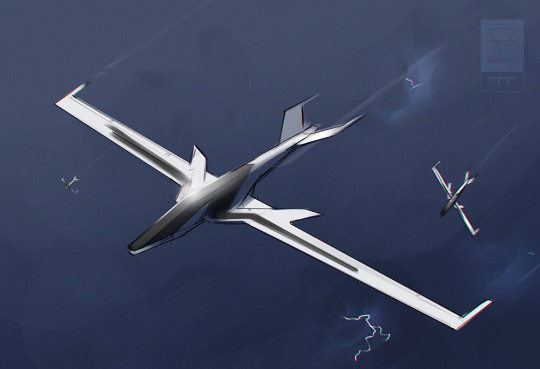
Nevertheless, I did actually run the maths. For the altitude, I learned that at the altitude of Neptune where the air pressure was around 1 atmosphere, the air density (which is important for flight) was about the same as Earth at 9km above sea level—the same as a commercial airliner. So, pretty viable, it's like flying a jetliner, except you don't actually need to pressurise because the air pressure outside is the same as inside. You would have to air seal, though, since the atmosphere is absolutely not breathable. Oh, and it's also -200°C.
More importantly, though, that placed the rough flight level of these gliders right on the cusp of the cloud levels. They can be in and out of them...how fantastic! Lots of swirling ideas of the kinds of scenery you'd be able to see, living a life in the eternal deep blue...
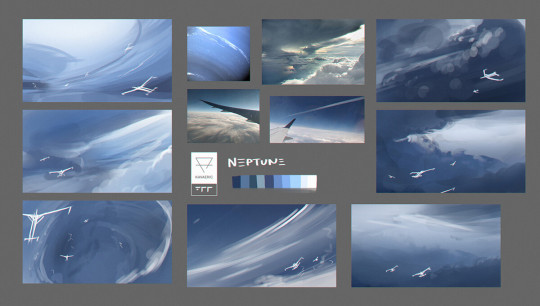
Around this time I also got in contact with a Twitter fan of mine who just happened to be an aerospace engineer (though, like everyone in the STEM department, they do fullstack software/web development now). Ran the idea by them...apparently it checked out. That's that diagram you see in the main photogrid above, with every glider under going a steady, gentle up and down motion between a higher fast air current and a lower slow one.


If there's one thing I wish was better? It's actually the final painting. I wanted to get the scale of the city-glider across, but I think this composition wasn't really the best. In theory the one-person glider should give an idea of how big the city-glider is on scale, but I don't think it was really clear, and the lack of atmospheric depth doesn't really convey the size.
This remains one of the top pieces I would love to redo at some point.
#light era#kouwa#artwork backlog#science fiction#scifi#furry#futuristic#anthro#glider#aircraft#neptune#sky#painting#process#artwork commentary#worldbuilding#artwork
251 notes
·
View notes
Text
What are exoplanets, and how do we detect them?
Post #16 in Physics and Astronomy, 14/01/2023
Welcome back,
First of all: what are exoplanets?
An exoplanet, by definition, is a planet outside our solar system that usually orbits another star within the galaxy. The exoplanets we’ve discovered so far have all been in relatively close proximity, due to limitations in the range of today’s telescopes.
You may have heard of Proxima Centauri b, the exoplanet closest to Earth, resting 4.2 lightyears away from us. Described by NASA as “a potential rocky world, larger than Earth,” it’s kind of a big deal, since it boosts evidence that planets in habitable zones* exist, and are probably quite close to us. We don’t know, however, if the planet has an atmosphere.
*habitable zone: a distance at which temperatures are right for liquid water. Also referred to as the ‘Goldilocks zone.’
How do we detect exoplanets?
There are a number of techniques used by scientists to detect exoplanets, but the two main ones are the transit and radial velocity methods.
Transit: when a planet passes exactly between us and a star it orbits, some of the light provided by the star is blocked. The blockage may be miniscule, nearly imperceptible, but it is still there. It’s just about enough for astronomers to realise that there may be an exoplanet orbiting a star.
Radial velocity: when planets orbit stars, the stars tend to “wobble” a little, i.e. they have an extremely small orbit of their own. This “wobble” changes the colour of light that astronomers see when they observe stars. The light is shifted; if the star is moving in the observer’s direction, it’s shifted to the blue end of the spectrum, and if the star is moving away from the observer, it’ll be red-shifted.
The categories of exoplanets
Gas giants: large planets composed almost entirely of helium and/or hydrogen. Examples familiar to you may include Jupiter or Saturn. Gas giants don’t have hard surfaces; instead, gases swirl above a solid core. However, gas giant exoplanets can be several orders of magnitude larger than Jupiter!
Super-Earths: planets a lot larger than Earth, yet lighter than ice giants like Neptune and Uranus. These can be made of gas, rock, or an arbitrary combination of both. The second closest to us, at the time of writing, is Barnard’s Star b.
Neptunian planets: these are similar to the size of Neptune or Uranus in our solar system. These typically have hydrogen- and helium-filled atmospheres, accompanied by cores of rock and other heavy metals. To date, 1,912 have been discovered, and an example you may recognise is Kepler-1955 b!
Last, but not least, terrestrial planets: examples of these may include Earth, Mars, Mercury, and Venus. For planets outside the solar system, those between half Earth’s size and twice its radius are considered terrestrial. Some rocky exoplanets twice the size of Earth could be terrestrial, but they can also be considered super-Earths. The number of confirmed discoveries for terrestrial planets is a lot lower than Neptune-like planets: we currently have 199!
***
In case you're interested in exploring exoplanets further, I've included a range of NASA web pages so you can do so!
#studyblr#alevels#sixth form#gcse#100 days of productivity#stem#physics#engineering#a levels 2025#astronomy#exoplanets#astrophysics#astrophotography#space#space blog#i love physics#stars#cosmology#astro posts
21 notes
·
View notes